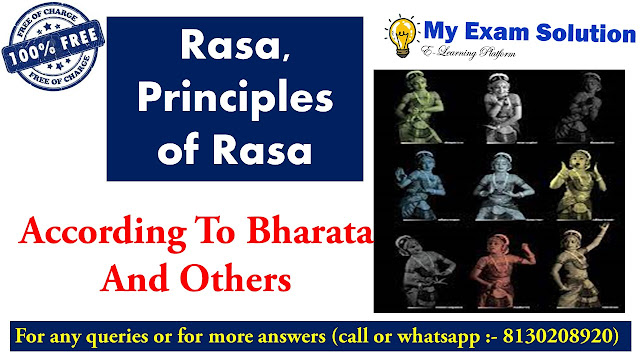Rasa, Principles of Rasa according to Bharata and others
Rasa, in Indian aesthetics and classical performing arts,
refers to the emotional flavor or essence that is evoked in the audience
through the performance. The principles of Rasa were first discussed in ancient
Hindu texts, such as the Natya Shastra by Bharata Muni, as well as later works
such as Abhinavagupta's Abhinavabharati and Rasarnavadipika.
According to these texts, there are 8 or 9 primary Rasas
(depending on the interpretation), including Shanta (peace), Hasya (humor),
Karuna (sorrow), Raudra (anger), Vīra (heroism), Bhayanaka (terror), Bībhatsa
(disgust), and Adbhuta (wonder). The ninth rasa, Shringara (romantic love), is
sometimes considered a subset of the Karuna rasa.
The goal of a performance is to evoke these Rasas in the
audience through various means, such as acting, music, and dance. The performer
must have a deep understanding of human emotions and the audience's mind in
order to effectively evoke a particular Rasa. The Rasa experience is seen as a
transformative one, in which the audience transcends their ordinary state of
mind and experiences elevated emotions.
What are the 8 types of rasa
The eight primary Rasas (emotional flavors or essences) in
Indian aesthetics and classical performing arts are:
- Shanta (peace)
- Hasya (humor)
- Karuna (sorrow)
- Raudra (anger)
- Vīra (heroism)
- Bhayanaka (terror)
- Bībhatsa (disgust)
- Adbhuta (wonder)
These Rasas are considered the universal emotions that are
common to all humans and can be evoked through performance. The goal of a
performance is to evoke these emotions in the audience and provide them with a
transformative experience.
How many rasa are there in rasa theory
In the Rasa theory of Indian aesthetics and classical
performing arts, there are typically 8 or 9 primary Rasas (emotional flavors or
essences). The number of Rasas can vary depending on the interpretation, but
the most commonly recognized number is 8. The 8 primary Rasas are:
- Shanta (peace)
- Hasya (humor)
- Karuna (sorrow)
- Raudra (anger)
- Vīra (heroism)
- Bhayanaka (terror)
- Bībhatsa (disgust)
- Adbhuta (wonder)
Some interpretations may include a ninth Rasa, Shringara
(romantic love), as a subset of the Karuna Rasa.
Who introduced 9 rasa
The concept of 9 Rasas (emotional flavors or essences) in
Indian aesthetics and classical performing arts was introduced by the ancient
Indian aesthetician and scholar, Abhinavagupta. He was a prominent figure in
the field of Indian aesthetics, philosophy, and performance arts, and his work
Abhinavabharati is considered a seminal text on the subject of Rasa.
In his work, Abhinavagupta expanded on the earlier theories
of Rasa by Bharata Muni, and added a ninth Rasa, Shringara (romantic love), to
the list of primary Rasas. His interpretation of the Rasas and their role in
performance became highly influential in later Indian aesthetics and continues
to be studied and referenced today.
What is rasa and its types
Rasa is a Sanskrit term that refers to the emotional flavor
or essence that is evoked in the audience through a performance in Indian
aesthetics and classical performing arts. The goal of a performance is to evoke
these emotions and provide the audience with a transformative experience.
There are typically 8 or 9 primary Rasas recognized in Indian
aesthetics, depending on the interpretation:
- Shanta (peace)
- Hasya (humor)
- Karuna (sorrow)
- Raudra (anger)
- Vīra (heroism)
- Bhayanaka (terror)
- Bībhatsa (disgust)
- Adbhuta (wonder)
Some interpretations may include a ninth Rasa, Shringara
(romantic love), as a subset of the Karuna Rasa. These Rasas are considered the
universal emotions that are common to all humans and can be evoked through
performance. The performer must have a deep understanding of human emotions and
the audience's mind in order to effectively evoke a particular Rasa.
ALSO READ:-
Folk fairs & festivals in India
Folk Music Origin, evolution and classification of Indian folk song / music
Ragas and Talas used in folk music
Whatsapp :- 8130208920
Youtube :- Myexamsolution







0 comments:
Note: Only a member of this blog may post a comment.